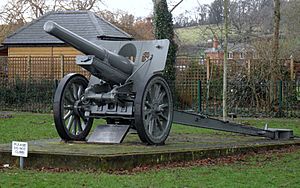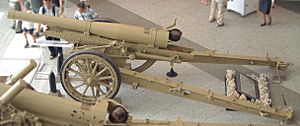Type 96 15 cm howitzer facts for kids
Quick facts for kids Type 96 15 cm howitzer |
|
|---|---|
 |
|
| Type | Howitzer |
| Place of origin | |
| Service history | |
| In service | 1937–1945 (Japan) |
| Used by | |
| Wars | Second Sino-Japanese War Soviet-Japanese Border Wars World War II Indonesian National Revolution Malayan Emergency Chinese Civil War Korean War |
| Production history | |
| Designed | 1920–1934 |
| Unit cost | 43,500 yen ($11,689 USD) in August 1939 |
| Produced | 1937–1945 |
| No. built | 440 |
| Specifications | |
| Mass | 4,140 kg (9,130 lb) Firing, 4,920 kg (10,847 lb) Traveling |
| Length | 6.71 m (22 ft 0 in) Firing, 9.25 m (30 ft 4 in) Traveling |
| Barrel length | 3.523 m (11 ft 7 in) 23.37 calibers |
| Width | 1.65 m (5 ft 5 in) |
| Height | 2.01 m (6 ft 7 in) |
|
|
|
| Shell | 31.3 kg (69 lb) |
| Caliber | 149.1 mm (5.87 in) |
| Carriage | Split trail |
| Elevation | -5 to +65 degrees |
| Traverse | 30° |
| Rate of fire | 3–4 rpm |
| Muzzle velocity | 540 m/s (1,772 ft/s) |
| Maximum firing range | 11,900 m (13,014 yd) |
| Sights | panoramic |
The Type 96 15 cm howitzer was a powerful cannon used by the Imperial Japanese Army during World War II. It was a type of howitzer, which is a large gun that fires shells in a high arc. This allowed it to shoot over hills and obstacles.
This howitzer was designed to replace an older model, the Type 4 15 cm howitzer, starting in 1937. It quickly became the main heavy artillery gun for the Japanese Army. The name "Type 96" comes from the Japanese calendar year 2596, which was 1936 in the Western calendar.

Contents
How the Type 96 Howitzer Was Developed
Work on creating a new howitzer for the Japanese Army began in 1920. It took more than ten years to design and test. During World War I, Japanese military experts saw how effective big guns were. They learned that artillery could help a lot against enemy defenses and soldiers.
The army wanted a howitzer that could shoot shells very high, up to 65 degrees. It also needed to fire shells about 12,000 yards (about 11 kilometers). The design also required it to be moved by a team of six horses. The new design was ready by 1934. However, the Army Chief of Staff, Kazushige Ugaki, wanted more improvements. Production finally started in 1937. In total, 440 of these howitzers were made.
The Type 96 howitzer had a fairly short barrel. It also had special parts that could be removed for easier transport.
Design and Features of the Howitzer
Experts from the Allies of World War II thought the Type 96 15 cm howitzer was one of Japan's best weapons. It was well-designed and very effective. The howitzer had strong, rubber-covered wooden wheels. It was usually pulled by a tractor.
One special feature was its ability to aim very high, up to 65 degrees. To do this, a deep hole had to be dug under the gun's breech (the back part where shells are loaded). Even though many Type 96 howitzers were made, they did not completely replace the older Type 4 howitzer.
The Type 96 was heavier than the Type 4. It could also shoot a bit farther. When moving, it was lifted onto a special spring system. When it was time to fire, the spring was lowered so the gun rested on its axle. The Type 96 used the same types of ammunition as the Type 4.
The howitzer could fire different kinds of shells. These included high-explosive shells that blew up on impact. It also used armor-piercing shells to break through defenses. Other types included shrapnel shells, smoke shells, and incendiary tracer shells that could start fires.
Where the Type 96 Howitzer Was Used
The Type 96 15 cm howitzer was first used in the Second Sino-Japanese War. Soldiers who used it thought it was a great weapon. It was also used in the Soviet-Japanese Border Wars, specifically at the Nomonhan Incident.
During the Pacific War, the Type 96 was sent to Japanese units. It saw action in the Battle of Bataan and Battle of Corregidor in the Philippines. It was also used in the Battle of Guadalcanal. Many of these howitzers were present at the Battle of Okinawa and in the Soviet-Japanese War. The Type 96 remained the main heavy gun for Japanese artillery until World War II ended.
Where to See a Type 96 Howitzer Today
You can see a surviving Type 96 howitzer at the Yushukan Museum in Yasukuni Shrine in Tokyo, Japan.
Other examples can be found in different places:
- In a parking lot in Bellevue, Washington, USA.
- In front of the Veterans Memorial Building in San Luis Obispo, California, USA (though it's not in the best condition).
- On display in Olathe, Colorado, USA, at Lions Park.
- In Romsey, Hampshire, UK, at the war memorial park. This one was captured by Louis Mountbatten.
See also
 In Spanish: Obús Tipo 96 150 mm para niños
In Spanish: Obús Tipo 96 150 mm para niños


